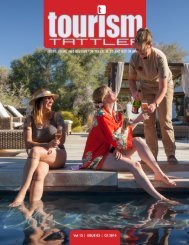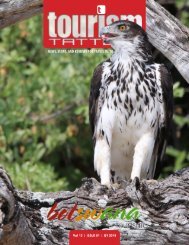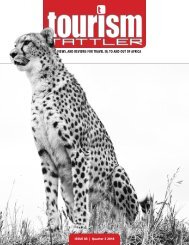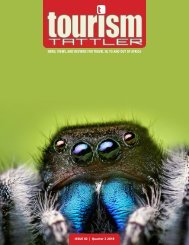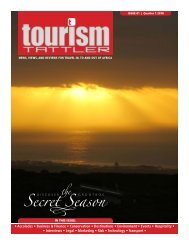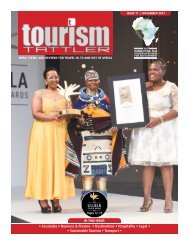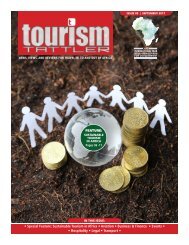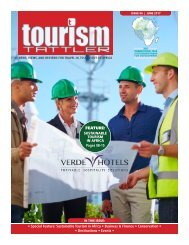Tourism Tattler May 2017 Edition
Our May edition features Karongwe Portfolio, Hotel Verde and Jaci’s Lodges - three prime examples of eco-friendly properties in South Africa who meet, and even exceed expectations as outlined in the UNWTO 2017 International Year of Sustainable Tourism for Development initiative.
Our May edition features Karongwe Portfolio, Hotel Verde and Jaci’s Lodges - three prime examples of eco-friendly properties in South Africa who meet, and even exceed expectations as outlined in the UNWTO 2017 International Year of Sustainable Tourism for Development initiative.
Create successful ePaper yourself
Turn your PDF publications into a flip-book with our unique Google optimized e-Paper software.
ATTRACTIONS<br />
Image courtecy of Mercedes-Benz Commercial Vehicles<br />
is required to see the potential and develop a vision for the region.<br />
The establishment and conceptualisation phase of a route as shown in<br />
Figure 5.1 contains nine steps, which could take between one and five<br />
years to complete. Precision and inclusiveness are required during the<br />
establishment and conceptualisation phase to ensure the desired longterm<br />
effects.<br />
Firstly, the route must be conceptualised based on solid market research,<br />
which identifies key target markets and their requirements. Market<br />
research must be conducted on a continuous basis to ensure that the<br />
latest tourism trends are included into objectives and strategies for the<br />
area. When budgets are tight, it is necessary to align the destination to a<br />
local, regional or provincial tourism authority or link to a local university<br />
to provide students or volunteers to assist with market research.<br />
Secondly, an audit of tourism products within the designated area must<br />
be conducted. This audit may include the natural environment, manmade<br />
products and human assets.<br />
Assessments of existing product must be conducted to ensure that<br />
products are keeping up to date with the changing dynamics of the<br />
tourism industry. The association must clearly determine a minimum<br />
standard (equal or higher than the national grading system) for<br />
members and a system for regular re-assessment. Failing to set minimum<br />
standards, might jeopardise tourist experiences in the area and cause<br />
negative marketing which, in the long run, may result in unsuccessful<br />
destinations.<br />
Unique selling features<br />
The third step is to scrutinise the tourism assets and identify the unique<br />
selling features or experiences of the area and its products. Unique<br />
features are extremely important to distinguish and position the<br />
destination in the market place. Once the unique selling features have<br />
been identified, a macro level strategic plan must be conducted that<br />
combines the market requirements and the tourism assets of the region,<br />
providing a consolidated approach towards the future development of<br />
the area. It is important that the area consults its local, regional and<br />
provincial authorities regarding its strategy and future plans for the<br />
area. This will ensure that the envisaged route coincides with the macro<br />
planning for the region and potentially could link with broader planning<br />
or funding initiatives. The next step will be to determine the potential size<br />
of the possible membership base.<br />
<strong>Tourism</strong> products with the ability to complement the unique features<br />
and main themes of the route must be lobbied to join the organisation<br />
from the early stages. If a legal structure is not yet in place, legal<br />
advice must be sought on the best structure suitable for any potential<br />
management organisation. Once the organisation is formed, specific<br />
portfolios for committee members must be developed according to the<br />
identified strategic objectives and to ensure nominated members have<br />
the willingness and experience to perform within these portfolios.<br />
Mentorship<br />
It is advisable to incorporate mentorship within the committee and subcommittees<br />
or task teams for sustainability of skills. Care must be taken<br />
not to incorporate products that are not complementary to tourism<br />
or the envisioned branding and values of the area for revenue gain.<br />
The association should avoid putting dominant members who act for<br />
personal or political gain into management positions. It is also important<br />
to be inclusive of all stakeholders within the region to ensure that the<br />
benefits are shared by all members of the community.<br />
Further, destination managers should encourage product diversification<br />
in the area by putting systems in place to incentivise the correct product<br />
mix for the area. For example, it is not healthy for an area to have only<br />
accommodation establishments. Accordingly, an association in an area<br />
with many accommodation establishments should have high joining fees<br />
for products falling within this category.<br />
Research conducted as part of this study shows the importance of unique<br />
attractions in a destination and how these products could be used as<br />
draw-cards to induce the use of support services. Special events can also<br />
be used to produce the same effect.<br />
About the author: Marlien Lourens wrote the content of this article as part of<br />
a dissertation document submitted to the University of the Witwatersrand,<br />
School of Geography, Archaeology and Environmental Studies in fulfilment of the<br />
requirements for a Masters Degree in <strong>Tourism</strong> in July 2007.<br />
MAY <strong>2017</strong> <strong>Tourism</strong> <strong>Tattler</strong> Trade Journal 15






